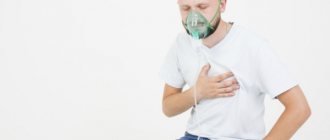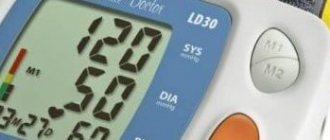Shortness of breath and palpitations are two accompanying symptoms that can indicate both serious illnesses and isolated deviations in health. It is very important to be able to independently determine the causes of these conditions in order to provide timely help to yourself or others.
Before you figure out what caused such unpleasant symptoms, you need to study the terminology. Shortness of breath is a feeling as if the body cannot get enough air with each breath. But heart rhythm disturbances are characterized by the presence of additional or missed heart beats, as well as abnormal noises.
Psychogenic shortness of breath - where does it come from?
Dyspnea is a disturbance in the frequency, rhythm and nature of breathing. There are pathological and nervous types.
With pathological shortness of breath, the cause lies in the disruption of the internal organs.
Psychogenic or nervous dyspnea develops primarily against the background of mental and nervous disorders:
- acute or chronic stress;
- psychogenic childhood - perhaps in childhood a person witnessed the occurrence of an attack of suffocation for various reasons. For example, a picture of drowning is accompanied by a convulsive swallowing of air by the drowning person, a characteristic facial expression;
- neurasthenia, neurosis, hysteria;
- depression;
- phobias, anxiety disorders;
- disorders of the autonomic nervous system – neurocirculatory dystonia;
- sleep disorders.
The symptom is difficulty breathing. It becomes superficial, with complicated short inhalations and long exhalations. His pace quickens, and even if a person manages to take a deep breath, it does not bring him much relief. This work of the lungs is called the breathing of a driven dog.
After uncontrolled accelerated respiratory movements there is a pause, and after it, convulsive breathing returns. All this causes anxiety and fear of approaching death in a person. A panic attack often occurs.
Distortion of the respiratory rhythm causes hyperventilation of the lungs and tension of the intercostal muscles. Because of this, false signs of angina pectoris and cardioneurosis develop. The patient is accompanied by weakness and malaise, excessive sweating, dizziness, cold extremities and convulsions.
Naturally, such symptoms suggest a heart disease, but it’s all about nervous tension.
Other signs of neurotic shortness of breath include:
- feeling of constriction in the chest;
- feeling of lack of air;
- control over the breathing process;
- feeling of a lump in the throat;
- attacks of neurotic cough - it becomes dry and annoying;
- nervous yawning;
- pain in the intercostal spaces;
- reflex movements to open the chest, which should help you take a breath - swinging your arms, straightening your shoulders, but they do not bring results;
- fear of death.
Nervous shortness of breath worsens a person’s mental state. It can cause depression, hypochondria, and mood disorders.
Edema and heart failure
Edema is not always a sign of heart failure. Their most common cause is peripheral venous insufficiency. Due to the expansion of the veins and the incompetence of the venous valves, the blood does not overcome gravity well (it is difficult to climb up the veins of the legs), stagnates in the legs and part of the plasma goes into the tissues. Such swelling is treated with compression hosiery, venotonic drugs, and in severe cases - with surgical methods.
There are still many causes of edema, so if you do not have obvious heart disease, but edema appears, first be examined by a competent therapist.
The main causes of edema:
- Peripheral venous insufficiency
- Lymphostasis
- Taking calcium antagonists, oral contraceptives, non-steroidal anti-inflammatory drugs
- Heart failure
- Liver diseases (liver cirrhosis)
- Kidney disease (severe renal failure)
- Compression of large vessels by the tumor
- Idiopathic edema
I’ll write separately about swelling on the face, which is very frightening for women and which for some reason is popularly considered “renal.” In fact, this is most often a purely cosmetic problem rather than a disease. There is fatty tissue around the eyes that reacts to changes in the amount of fluid around and accumulates water very well. With excessive consumption of salt and liquid, there is a slight increase in the volume of this periocular tissue. In this case, you just don’t need to eat salty foods or drink a lot at night.
Development mechanism and distinction criteria
Each activity, including breathing, is regulated by a specific part of the brain. In a state of stress and nervous overstrain, the central and peripheral nervous systems fail. Control over the breathing center in the brain is lost, overexcitation spreads, resulting in faster breathing.
The lungs become overfilled with air, causing hypocapnia, that is, the amount of oxygen in the blood increases excessively, and carbon dioxide decreases below normal. This imbalance of gases causes an attack of psychogenic shortness of breath.
Despite the fact that the symptoms of its manifestation are similar to true shortness of breath, there are still some criteria that allow it to be differentiated:
| Types of shortness of breath Criteria | Psychogenic | True |
| Cause | Examination of internal organs fails to detect | Pathology of the heart, kidneys, lungs, etc. |
| Bodily symptoms | None | Pale or cyanotic skin, barrel chest, edema |
| Changing body position | Does not affect breathing pattern | A change in position can alleviate or provoke a pathological symptom. It often intensifies especially after physical activity. |
| Nature of violations | Fickle | Constant |
| Periodicity | It worsens due to the weather, at certain times of the day (for some, attacks occur in the morning, for others - at night). It appears more often in spring and autumn. | |
| Cough | Not controlled by medications | In some cases, it can be treated with medication |
| Switching attention | All symptoms go away if you move the conversation in a different direction | Shortness of breath persists, no connection |
2.When is shortness of breath normal?
Although shortness of breath is always an unpleasant condition, it should only be a concern in cases where it indicates a disorder in the body. If a person has been exposed to physical exertion, experienced stress, or found himself in an extreme situation, shortness of breath is a physiological norm
and is in the nature of a compensatory mechanism. Rapidly climbing stairs, intense swimming, and lifting heavy objects cause rapid breathing even in the healthiest person. However, normally, after transitioning to a calm state, breathing should quickly recover, without causing a feeling of lack of air.
If shortness of breath occurs disproportionately to the impact received (during normal walking, when rushing, from a sharp sound, after bending over, lifting a heavy object once), this may indicate somatic diseases, infections, psycho-emotional or endocrine disorders.
Visit our Cardiology page
Respiratory neurosis
There are many types of neuroses, each of which is distinguished by a specific group of symptoms. One of them is respiratory neurosis, which is characterized primarily by neurogenic breathing disorder.
The concept was introduced into use in 1871 by the American scientist Da Costa. It has several related names: “respiratory neurosis”, “neurorespiratory syndrome”, “respiratory dystonia”. But the term most often used is “hyperventilation syndrome” (HVS) . It accounts for approximately 10% of cases. Among the patients there are both children and adults. It is worth noting that women suffer from this disease several times more often than men.
The causes of the syndrome are divided into mental, organic, and mixed. Of course, the majority (about 60%) is due to psychogenic factors.
5% of cases include organic etiology. These include disorders of the structure of the central nervous system: encephalopathy, hydrocephalus, inflammation of the meninges, as well as diseases such as diabetes, hypertension, chronic bronchitis. Sometimes the reason is taking certain medications.
During the course of the disease, there are 3 groups of signs:
- respiratory;
- psycho-emotional;
- muscular.
Group I has several forms of manifestations:
- Empty breathing is a feeling of lack of air, its pace quickens.
- It seems that air is forced into the lungs, and there is a lump in the throat. Accessory muscles are involved in the respiratory act.
- A premonition of breathing stopping appears, and the person is forced to control its process by consciously inhaling.
- Yawning, moaning, sighing.
Group II symptoms include nervous tension and concern about one’s condition. The patient cannot relax. He develops phobias, in particular, a fear of open areas and places with large crowds of people.
Symptomatic group III includes muscle hypertonicity, various tactile sensations in the form of tingling, burning, and “goosebumps.”
This triad of symptoms is a typical, leading manifestation of the disease.
The disease is characterized by a chronic course, in which exacerbations occur.
An exacerbation of hyperventilation syndrome is called a hyperventilation crisis. This is a condition in which the manifestations of the disease intensify. Characterized by an increased sense of fear. The patient is suffocating, hysterical, and feels “near death.” At the same time, he is accompanied by chills, dizziness, nausea, and becomes covered in sticky cold sweat.
A crisis is caused by a negative psychological environment. A unique way to relieve an attack is to breathe into a bag. In this case, carbon dioxide is concentrated in it, which the neurotic inhales. Gas balance is restored, breathing is leveled out. This is the first aid in this situation.
As for children, they are also characterized by such a pathology as respiratory neurosis, which is also caused by stress, phobias and anxiety disorders. But it is worth noting that the main role in their occurrence is played by an unfavorable situation in the family, and this applies not only to rude and inadequate attitude towards the child, but also to the relationship between parents. Constant quarrels and conflicts in the family, aggression can provoke the development of psychogenic shortness of breath in children.
Such children are characterized by anxiety and lability (instability) of mood. They experience outbursts of anger over trifles, general nervousness, refusal to communicate with friends, and sleep disturbances.
Parents should be more vigilant and sensitive in raising their children.
Conventionally, there are 3 types of shortness of breath
- inspiratory dyspnea (difficulty breathing) – more typical for heart disease
- expiratory shortness of breath (difficulty exhaling) – most often occurs in bronchial asthma due to spasms
- mixed shortness of breath (when both inhalation and exhalation are difficult) – characteristic of a variety of diseases
The most important method of combating shortness of breath is treating the disease that caused it. Once the specialist determines the cause, an effective treatment plan will be determined. For example, for coronary heart disease and myocardial infarction, treatment with tablets is often used. For bronchial asthma - regular treatment with inhalers. Since the main cause of shortness of breath in many cases is low oxygen levels in the body, oxygen therapy is one way to reduce shortness of breath.
Psychogenic asthma
In general, bronchial asthma refers to a pathology of the respiratory system. Its development is associated with changes in the structure of the bronchi against the background of immune failures, that is, it is a very specific disease, the etiology of which is not related to mental factors.
People suffering from this disease may develop a condition called psychogenic asthma. This happens when attacks of suffocation, the main symptom of the disease, are provoked by nervous overstrain, both positive and negative, whereas in normal cases this occurs under the influence of cold, infections or physical exertion.
Under the influence of super-emotions, histamine is released. This is one of the main mediators of inflammation. It causes bronchospasm. The result is a dry cough, shortness of breath and an attack of suffocation.
Psychogenic asthma often develops in women during the menstrual period and in children, whose psyche is still quite unstable and very sensitive.
Treatment of patients with shortness of breath
If an elderly patient experiences or worsens shortness of breath when walking, doctors prescribe treatment depending on the cause of the respiratory dysfunction. When treating shortness of breath that occurs or worsens during emotional stress, psychotherapists use an integrated approach using psychotherapeutic, medicinal, and physiotherapeutic techniques and measures.
If elderly people have shortness of breath caused by anemia, therapists provide individually selected therapy. When the hemoglobin level is 109-90 g/l, hematocrit 27-32%, a diet is prescribed, including iron-rich foods, salts, polysaccharide compounds of divalent iron, iron (III)-hydroxide polymaltose complex. If the hemoglobin level is below 90 g/l, the hematocrit is below 27%, a hematologist is consulted, and salt or polysaccharide compounds of divalent iron or iron (III)-hydroxide polymaltose complex are prescribed in a standard dosage. In addition to previous therapy, iron (III)-hydroxide polymaltose complex or iron III dextran is administered intravenously. Patients with severe anemic and circulatory-hypoxic syndromes are given infusions of leukofiltered erythrocyte suspension.
If the cause of severe shortness of breath when walking is heart failure, the following medications are prescribed:
- Angiotensin-converting enzyme inhibitors;
- β-blockers;
- Aldosterone receptor antagonists;
- Diuretics;
- Cardiac glycosides;
- Angiotensin II receptor antagonists.
Patients whose cause of shortness of breath, which worsens when walking, is bronchial asthma, are prescribed drugs that dilate the bronchi by reducing the tone of the smooth muscles of the bronchi, and improve bronchial patency by reducing inflammation of the airway wall.
If you are concerned about severe shortness of breath and palpitations when walking, make an appointment with a therapist online or by calling the contact center. After determining the cause of shortness of breath, the doctor will individually select the most effective drugs to restore respiratory function.
How is it detected?
If you experience symptoms of shortness of breath, you should consult a doctor. First of all, he must check whether the symptom is a sign of physical pathology. To do this, the doctor conducts a survey of the patient, and then proceeds to an objective examination: examines and listens to the patient.
To exclude diseases of internal organs, a number of examinations are prescribed:
- radiography;
- allergy tests;
- CT or MRI;
- ECG, ultrasound of the heart;
- UAC.
Without identifying pathology, the doctor sends the patient to a neurologist or psychotherapist.
The psychotherapist collects a psychogenic history, which includes information about the presence of mental disorders, possible traumatic factors, as well as developmental features in childhood.
Psychological analysis involves the study of personality, including through testing. The Nymigen questionnaire is especially effective, being effective in 90% of cases. It was developed by Dutch pulmonologists. Includes 16 positions characterizing the signs of hot water supply. Their severity is assessed within 0-4 points.
During the neurological examination, neurological symptoms are checked and excessive sweating of the palms and feet is determined. Electromyography may be performed.
Additional examinations include hyperventilation test, acid-base blood test, and electrolyte balance. As a rule, with neurogenic shortness of breath, a deficiency of magnesium and calcium in the blood is detected.
Diagnosis of breathing problems
When a patient first approaches with complaints of shortness of breath, the doctor prescribes a series of tests to determine the causes of the symptom. Depending on the results, the therapist will be able to refer the patient to see a specialized specialist. The following methods are used for diagnosis:
- x-ray to detect possible changes in the lungs;
- spirometry to measure volumetric parameters of external respiration;
- biochemical blood test - allows you to identify signs of respiratory failure;
- electrocardiography - to obtain data on heart activity;
- Laryngoscopy allows you to assess the condition of the mucous membrane of the respiratory organs.
Detection of anemia during acute lack of air may indicate the presence of serious diseases - ulcers of the gastrointestinal tract, renal failure, oncology. Based on the results, appropriate types of research are prescribed.
How to get rid of the feeling of suffocation
The question of how to treat psychogenic dyspnea includes a wide range of methods.
But the main thing is to restore a favorable psychological background. Only nervous calm will help eradicate the disease completely.
You can try to do this on your own.
- Take herbal infusions.
- Set up a daily routine. Sleep – at least 8 hours. Avoid overwork.
- Give up bad habits, as they produce a psychostimulating effect.
- Workout.
- Proper nutrition - more fruits and vegetables, less fatty, salty and spicy foods. It would be good to diversify the menu with products high in magnesium: pumpkin and sunflower seeds, nuts, wheat bran, dates, spinach, cocoa.
- Warm flavored, massage, hardening.
- Breathing exercises – helps to increase the level of CO2 in the blood and reduce the breathing rate.
It happens that neurogenic breathing disorder goes away on its own. For this, a change in the situation was enough, both in a positive and negative direction.
Here is the story of a guy who suffered from nervous shortness of breath for a long time and got rid of it without noticing it. The young man suffered from the disease for 6 years, starting at the age of 15. Attacks of suffocation plagued him so much that he was afraid to go outside for fear of suffocating. After a long examination, a diagnosis was made: “hyperventilation syndrome.”
Upon reaching conscription age, he was drafted into the army (he turned out to be fit). This fact added even more panic. The service was akin to hell. But six months later he suddenly realized that the attacks had subsided. He could finally breathe deeply. There was a feeling that a second wind had opened, and for him it was on the verge of bliss. The disease no longer bothered him.
If you cannot cope with the disease on your own, you will have to resort to the help of specialists and medications.
- Psychotherapy.
- Prescription of sedatives, antidepressants and tranquilizers. Vitamins B, D, magnesium and calcium preparations, as well as beta blockers.
- Special devices that train breathing and help normalize its rhythm. They restore respiratory frequency and relax muscles. Therapy takes place in the form of a game, allowing you to develop self-control, improve your psycho-emotional background, and increase resistance to stress factors.
- Physiotherapy – magnetic therapy, electrophoresis, galvanization, mud therapy.
- Sanatorium-resort holiday.
Nervous shortness of breath, while not a sign of physical pathology, is nevertheless dangerous to health. Its occurrence requires immediate therapeutic intervention to prevent persistent mental disorders and personality changes.
Symptoms of shortness of breath
In order to timely determine caused shortness of breath from abnormal shortness of breath, you need to calm down and not panic, carry out an analysis of the condition if possible and identify the signs:
- rapid pulse;
- difficult air intake;
- suffocation;
- cardiopalmus;
- weakness;
- unstable breathing when walking;
- dizziness;
- chest pain;
- pale skin;
- panic attacks;
- profuse sweating.
Return to contents
Atrial fibrillation
This pathology is often diagnosed in people after 40 years of age.
Atrial fibrillation is the most common cause of heart rhythm disturbances. This is a common deviation in people over 40. There is a significant risk factor for stroke, so timely consultation with a doctor becomes a vital measure. The pathology does not occur on its own, but manifests itself against the background of an existing disease or disturbances in the functioning of the cardiovascular system and rapid pulse. Signs are identical to those above, but are complicated by possible loss of consciousness and abnormally pronounced heartbeat.
Return to contents
Atherosclerosis
In the initial stages, the patient does not feel any symptoms or changes in his condition. Atherosclerosis or the accumulation of cholesterol provokes shortness of breath and heart rate due to atherosclerotic plaques sticking to the walls of blood vessels. As a result, blood circulation is disrupted, which gradually turns into oxygen starvation. The occurrence of such a disease is provoked by many factors: from bad habits and age-related changes to metabolic disorders, stress, a passive lifestyle and poor nutrition.
Return to contents
Lung problems
Pulmonary diseases often manifest as breathing problems.
Severe shortness of breath is a natural concept for patients suffering from dryness and respiratory tract diseases. There are pathologies that are not acquired, for example, low compliance of the lungs. Dyspnea occurs in people who have injured the thoracic region, have inflammation in the lungs, or suffered from dryness. Often these patients experience shortness of breath at night. The problem is also aggravated by difficulty in exhaling, as phlegm and mucus are found in the respiratory tract.
Return to contents
Anemia and its types
This disease develops in people with insufficient hemoglobin in the blood. The condition occurs due to intestinal problems, infectious diseases, due to a lack of vitamins and microelements. Anemia can be: microcytic, normocytic and macrocytic. They are classified according to the causes of occurrence and indicators of microelements in the blood. Signs and manifestations of the disease can be aggravated by an increase in the size of the liver and mental disorders.
Return to contents
Heart failure
Shortness of breath with this pathology appears against the background of fluid stagnation in the lung tissues, which occurs as a result of the inability of the heart to pump blood in the required volume. In the initial stages, dyspnea is typical after physical activity, and as it develops, it is also observed at rest. Depending on the degree of load on the heart and lungs, there are 4 stages, more details about which are in the table:
| Degrees | When does it appear? |
| 1 | After exercise |
| 2 | After moderate physical activity |
| 3 | Due to active manipulations and movements |
| 4 | At rest and during sleep |
Return to contents
Mitral valve prolapse
In most cases, the pathology does not pose a danger to the patient.
MVP is one of the heart defects in which contraction of the left ventricle occurs with pronounced bending of one or both leaflets. The pathology is moderate and not dangerous; many patients live with it all their lives. Main causes: congenital or acquired prolapse. The symptoms of the disease are identical, sometimes the patient experiences a burning sensation in the chest, and disturbances in the functioning of the nervous system appear. Main features:
- prolonged or short-term tingling in the heart;
- increased heart rate;
- radiating pain in the chest area.
Return to contents
Other diseases
Dyspnea is caused by many other reasons that negatively affect the functioning of the cardiovascular system and the person’s condition as a whole. The pathology often occurs in people with symptoms of tachycardia, increased emotional instability, and patients who drink large quantities of alcoholic beverages and caffeine-containing substances. In some cases, shortness of breath occurs while taking certain medications, such as corticosteroids and diuretics. This negatively affects the functioning of the heart and causes a rapid pulse.
Return to contents









